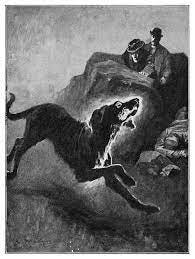“Footprints?”
“Footprints.”
“A man’s or a woman’s?”
“Mr. Holmes, they were the footprints of a gigantic hound.”
Since Sherlock Holmes in now fully in the public domain, I thought I’d continue to regale you with some of the nerding out I’ve done in the past about some of the little Easter-eggy* treats left for us Sherlockians by many of the adaptors of the stories into TV shows in particular.
Back on my blog, I used to have a series called The More You Holmes, which was a riff on the old TV spot The More You Know. Mine was, of course, all about Sherlock Holmes, and it began as an Easter-egg spotting game of mine within the BBC Sherlock show. Once that show declined and stopped, and as I began losing interest in that series (don’t get me started on Season 4–yeeesh), and started following Elementary, I added that show to my OG canon reference spotting game. I even got a good friend to design my very own logo for the series, based on The More You Know from NBC and customized for my use! How cool is that?
Here’s how the structure of these MYH posts usually went:
Episode number (season, ep#)
Event, Character, Quote, or Title
Reference: the original appearance in Doyle canon
and sometimes a wee bit o’ commentary on the contemporary sighting, its changes, modernizing, my opinions on the change, etc.
*An “Easter egg” is a term first used in video games in reference to fun little puzzle solutions, odd treasures or items, etc. that are hard to find and may or may not have to do with the game’s main storyline. The term then went on to be used for hard-to-spot references to original material in a current movie or show–e.g. references to comics in a Marvel movie, etc. At least I think so. Any linguists and pop culture experts, weigh in via comments, yeah?
Why did I pick Hound for my conglomerate post today? Well, I was partly celebrating the public domain status of Sherlock Holmes as of the other day, and I also was about to post an old lecturette from a class I taught to grad-level DU writing students from way back, called “Villains, Monsters, and Foes” and I thought about the stellar villains in Hound. Moriarty, you say? Ehh, we only see him once, in one story, and tbh he’s pretty disappointing in canon. The Hound villains are a lot worse. (Clutching your pearls? Talk about it in the comments. Go ahead.)
So here you go! This is a mashing-together of a few different More You Holmes posts from 2014, 2015, and 2016, which is when Sherlock and Elementary were in their heyday. Oh, and of course: SPOILERS for not only the canon tale, but these episodes as well.
…
From: ep. 2.2
Event: Dr. Frankland runs away from his pursuers into the Great Grimpen Mine Field, and there meets his death.
Reference: In the novel from which the ep is adapted, The Hound of the Baskervilles, it’s not Frankland but Stapleton who is the culprit. He flees from the pursuit of Watson, Holmes, and Lestrade through the Great Grimpen Mire, and it’s intimated he has sunk into the muck and died.

From: ep 2.2 again
Character Names: Most major characters in this episode are named directly from the novel on which this episode is based: The Hound of the Baskervilles. Below are the character names and their parallels in the story:
Henry Knight: The young heir to Baskerville Hall is named Sir Henry, and he is the inheritor of the house as well as the curse of the Hound from his father. The fact that young Henry’s surname is Knight is obviously a nod to his title in the book.
Corporal Lyons: Laura Lyons is a pivotal character in the book, having vital information about the murderer.
Major Barrymore: Barrymore is the butler at Baskerville Hall, and sports a square-cut black beard. Major Barrymore is similarly in charge of Baskerville the lab, and similarly sour in temperament as well. A delightful tidbit from the Blu-Ray commentary is that of course being in the Army, Barrymore would not have been allowed to have his beard, but the creators made him have one anyway, to more closely resemble his book counterpart.
Dr. Frankland: The bombastic father of Laura Lyons (Mr. in the book, not Dr.) is fond of lawsuits and owner of a big telescope, which is very helpful at one point of the story.
Dr. Stapleton: Mr. Stapleton is a naturalist (sort of close to the scientist this ep’s version is), and lives on the moor with a woman he calls his sister, but neither ends up being what they seem. Come to think of it, I can’t find Beryl Stapleton/Garcia’s parallel in this episode. Anyone notice something I’ve missed?
Dr. Mortimer: The family doctor is the one in the book who comes to Holmes in the first place, asking for his help. He saw the crime scene of Henry’s father, Charles’ death, and his beseeching phrase is quoted directly in the episode: “Mr. Holmes, they were the footprints of a gigantic hound!”
Selden: The prisoner hiding out on the moor doesn’t actually show up in the episode (other than a perplexing mention of “the bloody prisoner” by one of the landlords of the Cross Keys Inn when we first meet them), but when Watson is exploring what he thinks is Morse code (UMQRA), and comes across the snogging site, one can overhear a woman in an occupied parked car exclaim, “Mr. Selden, you’ve done it again!”
Fletcher: Not a character from the book itself, but a friend of Doyle’s irl who suggested the story’s main plot of the ghostly dog and curse. Fun fact: the scene where Sherlock baits Fletcher with a fake bet is from canon story “The Blue Carbuncle,” when Holmes does almost identically the same thing to Breckinridge the goose-seller to get information.
From: Elementary ep. 4.17
Event: (also character names, etc.) Charles Baskerville runs for his life (and dies) from something witnesses call a four-legged dog-like creature that glows.
Reference: Yup, basically the same event. Actually there are several Doyle canon references in this ep, as well as a few other nods to other Doyle stories and to the BBC series Sherlock. Here they are in list form:
Selden: the escaped convict wandering the moor, in this ep he’s an anti-GMO activist who online-rages at the Baskervilles and Stapleton’s company.
Stapleton: the naturalist and owner of the killer dog, in this ep he’s an engineer who works with the robotics that were stolen to create this story’s version of the Hound.
Charles, Henry, and Hugo Baskerville: like in the original, they’re all relatives in line for a large inheritance (large enough to kill for). There’s no mention of ancestor Hugo being a kidnapper and roysterer, however, beyond him being a railway baron. The Hall which Henry takes over is also called Baskerville Hall, and there’s a terrifying scene where he sees a mysterious creature outside his vast home that echoes the security lights scene in BBC Sherlock‘s version of this story.
Barrymore isn’t a butler in this ep, but he does supply inside information, here about Stapleton. Apparently Stapleton has been seeing prostitutes at a fancy hotel named Undershaw (another reference: this one to the name of Conan Doyle’s house).
References to a genetically modified “superdog” and inserting jellyfish genes into an animal to make it glow are echoes again of BBC Sherlock‘s “The Hounds of Baskerville.”
Laura Lyons: a pivotal minor character in the original, here she’s the remote murderer, owner of the robotic “hound” and attempting to claim the inheritance much like Holmes imagined Stapleton would have done in the original.
“The woman”: when Sherlock talks about Irene Adler to his morgue-doctor friend, he refers to her not by name, but as “the woman,” just as Holmes does in the original.
…
Happy New Public Domain, all! And let me know if you’d enjoy seeing more of these—there’s tons of them back at t’blog. I can collect a few by theme for you if you like.
And! For all of you who are paid subscribers, I’ll be re-publishing my retro-review of the Hound episode from BBC Sherlock fansite, Sherlock’s Home, which is no longer active but still hovers in the internet ether, since this week is apparently all about the Hound. I’ll be re-posting all those reviews (and, who knows, maybe I’ll finally get around to retro-reviewing Season 4!) on Wednesdays for you paying peeps. As for the rest of you, have a lovely first week of the year, and I’ll see you Friday for our vocab word of the week!




